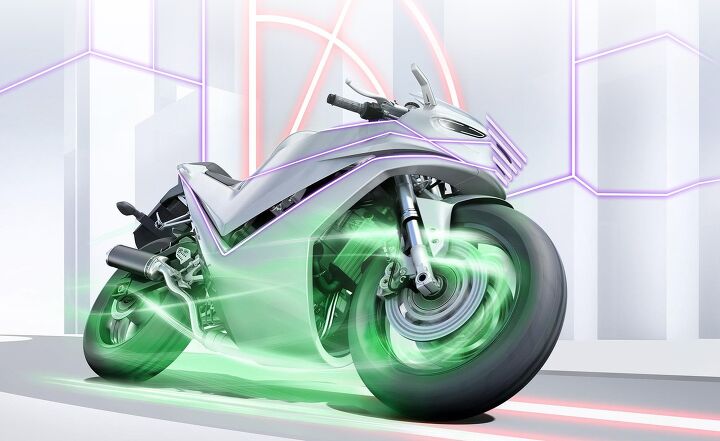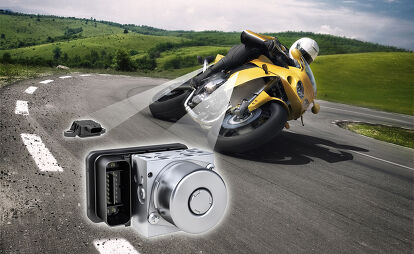Bosch Expands Its Portfolio Of Motorcycle Technology

Integration is the future of motorcycle electronics
Ask most motorcyclists about what role Bosch plays in our sport, and they’ll tell you that Bosch produces ABS technology and has been part of the recent trend towards expanding the technology into safety features like cornering ABS. All of this is true, but Bosch has its hands in so many areas of motorcycle technology that it would be hard to find one that the company is not currently developing. Last year, Bosch invited Kevin Duke and Tom Roderick to learn about how Bosch sees the future of technology-based motorcycle safety strategies and to sample cornering ABS in a controlled environment. Now, more than six months later we had an opportunity to sit down with Geoff Liersch, Head of the Bosch Two-Wheeler and Powersports business unit, to discuss what to expect from Bosch in the next few years.
Technological Strategies To Motorcycle Safety
Smartphone Integration
Both BMW and KTM will utilize Bosch instrumentation for 2017. Since the features will require more use of the screen, Bosch updated the manufacturing process for the TFT. Previously, the LCD and the glass of the screen were separate pieces. Now, the LCD is bonded directly to the glass. This has two benefits. First, it improves usability by reducing reflections. Second, the life of the unit is increased. Previously, the slight air gap between the LCD and the glass acted as an insulator, trapping heat similar to how a greenhouse captures the heat of the sun. According to Liersch, there are no functional negatives to this change besides the increase in manufacturing cost.
BMW Announces Intelligent Emergency Call System For Motorcycles
First seen on BMW motorcycles, the Bosch TFT display makes the move to KTM’s 2017 models. Both platforms will utilize Bosch’s mySPIN modular smartphone integration system. After connecting their phone to mySPIN on a motorcycle, the bike’s display can be used to access phone functions. These apps can be accessed by both the touch screen and the handlebar controls. The flexibility of mySPIN allows each manufacturer to specify which apps have access to the motorcycle’s systems through the use of an updatable, expandable whitelist of apps. “mySPIN for two-wheelers enables riders to bring their smartphone content to the motorcycle. It also provides all vehicle manufacturers with an open platform featuring an extensive range of options,” said Liersch.
As an example of how this would integrate into the riding experience, the mySPIN app would notice, through the bike’s CAN bus connection, that the fuel level is getting low and alert the rider to nearby gas stations. Integration with the rider’s address book would allow the rider to ignore non-essential phone calls and continue to focus on the ride by simply glancing at the name on the touch screen when the phone rings. Bosch has already announced a partnership with both the REVER and Genius Maps apps, both of which offer motorcycle-specific tracking and analytics in their apps.
In the future the Connectivity Control Unit (CCU), which BMW is using in its emergency calling system, will allow riders with different brands of Bluetooth communicators to talk using the CCU as an intermediary. Additionally, the system will communicate with other bikes via built-in wifi which has a longer reach than Bluetooth currently has.
ABS Technology
While ABS in various forms has been available in the high-end market for a while, it has gradually been working its way into lower-end machinery. For example, the displacement threshold for ABS is dropping as the technology advances. In the EU, all newly registered motorcycles with a displacement greater than 125cc from 2017 onward must utilize ABS, and the rest of the world isn’t far behind. In 2018, Japan and India will follow with Taiwan joining in 2019. Almost 90% of all motorcycles are produced in Asia and a large percentage of those are small displacement bikes destined for those domestic markets. That kind of production volume will drive the price of the technology down and speed its acceptance in other markets.
For example, the Bosch ABS 10 unit was announced at EICMA 2015. Last year, at EICMA 2016, the first production motorcycles utilizing the ABS 10 were unveiled. Available in the United States market in Spring 2017, the Kawasaki Versys-X 300 ABS will contain the unit, and in 2018, the Suzuki GSX-S125 ABS will also feature the system. The ABS 10 is 30% lighter and and 45% smaller than the previous generation ABS 9. Additionally, ABS 10 carries a lower cost for this price-sensitive market segment.
2017 Kawasaki Versys-X 300 Preview
Bosch produces the ABS 10 in both single- and dual-channel units that the OEM can choose from for various applications. According to Liersch, riders in different countries use their brakes in different ways. For example, Indian riders use the rear brake almost exclusively because of the poor surface of many roads. Unfortunately, that combination of road surface and braking technique leads to long stopping distances and many accidents. By fitting a single-channel ABS unit to the front brake, riders will be able to gain confidence in its capabilities while still using the rear brake in the way they are accustomed.
Another area in which Bosch has positioned itself in relation to a government requirement is engine management systems. In 2019–2020, the Indian government will require that all motorcycles have an engine management system for emissions control. Said Liersch, “The OEMS themselves, once they come to a stage where they’ve got a 100% fitment rate in one market, it’s actually easier for them to offer it in another market from a cost perspective. In 2020, 2021, 2022, we’ll see a natural flow into other markets.” While the engine management system is required from an emissions perspective, they will actually drive the inclusion of other technologies, like traction control or ride modes, as a means of differentiating between models. If this does happen, the scale of these markets may drop the price of these units to the point that we see these technologies in smaller, more price-point models here in the US.
The Road Ahead
With Bosch units managing both the ABS and engine performance, it should come as no surprise that the company has a semi-active suspension system coming in 2017. The Bosch SDCU will be used to increase both rider safety and comfort over a variety of road surfaces. For example, by tracking engine speed, throttle position, and bike speed the SDCU will be able to adjust the suspension on the fly to deliver maximum control during braking maneuvers. This will help to minimize the tendency for rear wheel lift during hard braking situations. For rider comfort, the semi-active suspension will automatically adjust damping characteristics to suit road surface conditions from billiard table smooth to freeway expansion joints to rough or broken pavement.
Given how quickly all this technology is evolving, we expect to learn more about it later in the year when Bosch – or an OEM – announce the motorcycle the Bosch SDCU will make its consumer debut in. Hold on, this is getting good.

Like most of the best happenings in his life, Evans stumbled into his motojournalism career. While on his way to a planned life in academia, he applied for a job at a motorcycle magazine, thinking he’d get the opportunity to write some freelance articles. Instead, he was offered a full-time job in which he discovered he could actually get paid to ride other people’s motorcycles – and he’s never looked back. Over the 25 years he’s been in the motorcycle industry, Evans has written two books, 101 Sportbike Performance Projects and How to Modify Your Metric Cruiser, and has ridden just about every production motorcycle manufactured. Evans has a deep love of motorcycles and believes they are a force for good in the world.
More by Evans Brasfield














































Comments
Join the conversation
Still no flying cars in the near future. Damn!
I have a monster 1200s and a 2016 Super Duke GT. I suddenly love semiactive suspension. It is magic and really helps braking. It is also nice that the KTM has your back with the Bosch ESC safety net. If I did not see the lights glashing on the dash, I thought it was me doing the impossible. Lol! I hope they make a retrograde ESC for the Monster like BMW is offering. ESC was mandated in vehicles in 2012 cuz it saves lives. I have a few friends that have disabled the safety devices in their motorcycles and cars and a few have ended up crashing into someone's house. The bikes/cars are so powerful in the 21st century and believe me why would you want to turn them off. Have participated in 2day BMW driving courses in South Carolina with M3/M5's and you learn how amazing ESC really is!